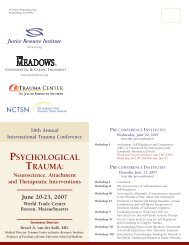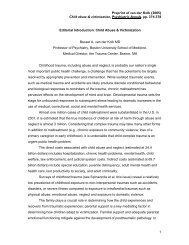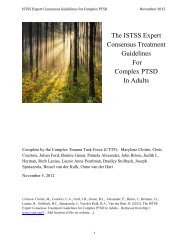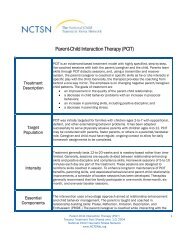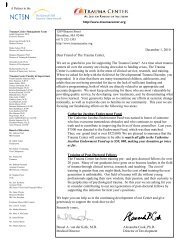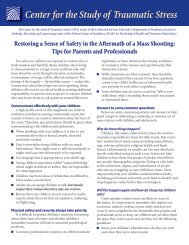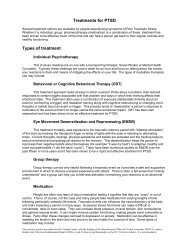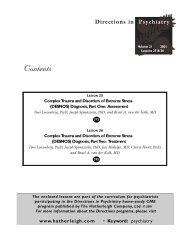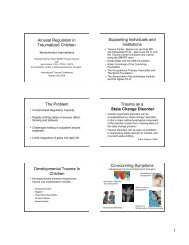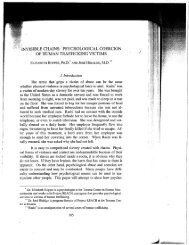in Child Welfare - The Trauma Center
in Child Welfare - The Trauma Center
in Child Welfare - The Trauma Center
You also want an ePaper? Increase the reach of your titles
YUMPU automatically turns print PDFs into web optimized ePapers that Google loves.
CW360 o <strong>Trauma</strong>-Informed <strong>Child</strong> <strong>Welfare</strong> Practice • W<strong>in</strong>ter 2013 25Cultural Adaptations of <strong>Trauma</strong> Treatments <strong>in</strong> Indian CountryWynette Whitegoat, AB, and Richard van den Pohl, PhD<strong>The</strong> National Native <strong>Child</strong>ren’s <strong>Trauma</strong><strong>Center</strong> at the University of Montana isfunded by SAMHSA as a Treatment andService Adaptation <strong>Center</strong> with<strong>in</strong> theNational <strong>Child</strong> <strong>Trauma</strong>tic Stress Network.<strong>Center</strong>s such as ours are charged withreplicat<strong>in</strong>g evidence-based trauma treatmentswhile adapt<strong>in</strong>g them to meet the needs oflocal communities. Our work has focused onprovid<strong>in</strong>g cognitive behavioral treatments,primarily Cognitive Behavioral Interventionfor <strong>Trauma</strong> <strong>in</strong> Schools, or CBITS (Jaycox,2004), <strong>in</strong> American Indian reservationschools. We also have worked to createtrauma-<strong>in</strong>formed behavioral health, juvenilejustice, and child welfare systems. Indianand non-Indian staff members’ backgrounds<strong>in</strong>clude psychology, education, social work,counsel<strong>in</strong>g, early childhood, law enforcement,and the military.Inclusion of traditional Native culturalactivities <strong>in</strong> evidence based trauma treatmentshas produced strong appreciation for ourwork by some tribal partners. It also hasproduced great concerns from other tribalpartners largely due to sacredness of culturalactivities. <strong>The</strong> use of traditional heal<strong>in</strong>gwith<strong>in</strong> the Native communities we work withis seen to be the most reasonable option <strong>in</strong>rega<strong>in</strong><strong>in</strong>g health and balance. Because cultureplays a critical role <strong>in</strong> facilitat<strong>in</strong>g heal<strong>in</strong>gamong Natives, it is seen as an essentialneed toward wellbe<strong>in</strong>g. Although all tribesare different <strong>in</strong> culture and hold a variety ofperspectives and philosophies, the majoritydo share similar beliefs on the importance ofwellbe<strong>in</strong>g. <strong>The</strong> psychological, social, physical,and spiritual dimensions are <strong>in</strong>terconnectedand should be treated as one (LaFromboise,Trimble, & Mohatt, 1990). Ceremonies andother traditional practices br<strong>in</strong>g comfort,hope, and rebalance to these four dimensionsfound with<strong>in</strong> <strong>in</strong>dividual clients and theircommunity (McCabe, 2007). Not onlydoes traditional heal<strong>in</strong>g provide options forrestoration but also <strong>in</strong>creases opportunities forcultural preservation, re<strong>in</strong>forcement of ethnic/tribal identity, and connection to culture andthe community (Hartmann & Gone, 2012;McCabe, 2007; Ranford, 1998).While adaptation of evidence-basedtreatments may seem <strong>in</strong>compatible withhigh fidelity replication, we have foundthat adaptations can enhance acceptability,susta<strong>in</strong>ability and effectiveness of traumatreatments. Most tribal communities <strong>in</strong> theUnited States experience some distrust ofoutsiders (Yellow Horse Brave Heart, 2003),particularly child welfare workers. Whethera Tribe has experienced theft of deceasedgrandparents’ rema<strong>in</strong>s or whether “research”has been conducted that perpetuated racialstereotypes, there are good reasons for tribalmembers to be skeptical of outside expertswho offer simplistic solutions for complexproblems (Gone & Alcantara, 2007). Whilenot conducive to short-term change, we havedeveloped three developmental approaches thatseem to support long term relationships withTribes and tribal members. First, we only work<strong>in</strong> communities where we have been <strong>in</strong>vited.Second, we consider that all data result<strong>in</strong>gfrom tribal partnerships are the property ofthe Tribe; the Tribe may or may not give uspermission to dissem<strong>in</strong>ate those data. Third, <strong>in</strong>addition to protect<strong>in</strong>g <strong>in</strong>dividual identity, wedo not disclose the identity of a Tribe unlessthe Tribe asks us to do so.We also have found it valuable to engagelocal community members <strong>in</strong> participatorydialog regard<strong>in</strong>g their perceptions of thevalue of treat<strong>in</strong>g childhood trauma, whatthe outcomes of successful trauma treatmentWhile adaptation of evidence-based treatments may seem <strong>in</strong>compatiblewith high fidelity replication, we have found that adaptations can enhanceacceptability, susta<strong>in</strong>ability and effectiveness of trauma treatments.should look like, and whether there alreadyare traditional support strategies that couldbe blended with the evidence-based traumatreatment. While some local adaptationshave been procedural (e.g., <strong>in</strong>vit<strong>in</strong>g studentsto draw a picture to supplement their oraltrauma narrative), we also have <strong>in</strong>vited localcultural experts to contribute traditionallanguage and traditional heal<strong>in</strong>g strategiesdur<strong>in</strong>g group trauma treatment.In some communities, our early effortsto <strong>in</strong>clude traditional Native language andculture stimulated apprehensions among ourtribal partners. One set of concerns <strong>in</strong>volvedthe proprietary nature of Native languageand culture. Closely l<strong>in</strong>ked were perceptionsthat researchers might exploit or otherwiseprofit from <strong>in</strong>formation shared by healers andElders, and because we do this work as partof our university employment, we cannotcompletely nullify this perception.To date, no Tribe has refused our requestto share results of trauma treatment. However,the extent to which we discuss traditionallanguage and culture follows one of threeprotocols. <strong>The</strong> protocol that is followedis determ<strong>in</strong>ed by Tribal Council decisionwith recommendations from Elders. In thefirst case, traditional language and heal<strong>in</strong>gceremonies are made available to childrenand youth who choose them, but whetherand how that occurs is not disclosed <strong>in</strong>our dissem<strong>in</strong>ation. In the second case, wereport that a community volunteer withexpertise <strong>in</strong> language and culture participated<strong>in</strong> the trauma treatment program, butthe <strong>in</strong>tervention(s) he or she used are notrecorded, named or described. In the thirdcase, the traditional ceremony may be namedand may be described. In every case, we<strong>in</strong>form the Tribal Council of our f<strong>in</strong>d<strong>in</strong>gsbefore dissem<strong>in</strong>at<strong>in</strong>g elsewhere.<strong>Child</strong> welfare (CW) workers may beperceived as “outsiders,” for example, ifthey are employed by the Bureau of IndianAffairs, a federal agency. In recent years,BIA has employed Native workers whoalso are community members—a practiceconsistent with Indian self-determ<strong>in</strong>ation.Alternatively, Tribes can provide their ownchild welfare services. Regardless of agencytype, CW workers face enormous challenges<strong>in</strong> child protection as the families they servefrequently are both neighbors and relatives.<strong>The</strong> adoption of Differential Response (DR)services has dramatically shifted the CWworker role from <strong>in</strong>vestigation only to a more<strong>in</strong>tegrated approach of family support servicescoupled with ensur<strong>in</strong>g child safety. SuchCont<strong>in</strong>ued on page 38Practice




